|
|
Post by griffin on Aug 8, 2015 16:24:14 GMT 10
Crusader Caravans
Mr. Mackenzie,
65 Crisp Street,
Hampton, Vic.
Nearly 10 years ago I obtained a copy of a photograph from the Vauxhall Owners' Club library showing a 1935 14hp DX Vauxhall towing a very unusual shaped van. The photo had no information recorded on it and I thought it was probably a home built van. This is the van:
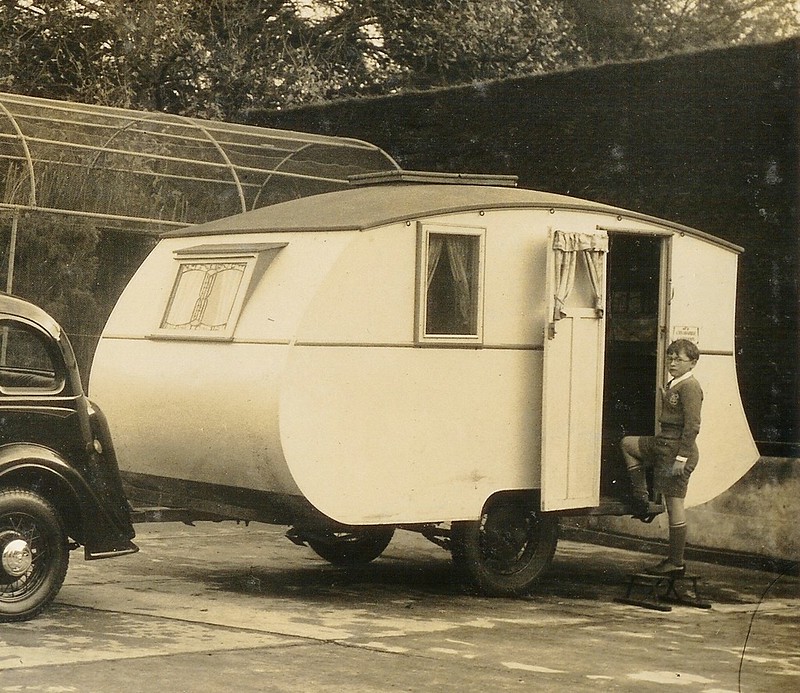 1935 DX with caravan-e by viva gt, on Flickr 1935 DX with caravan-e by viva gt, on Flickr
In my view a great looking little van with the concave rear, cambered roof and a rear entry door, it really ticks the boxes for me and if I were that way inclined I would happily build a replica.
Recently while catching up with additions of 'Table Talk' magazine on 'Trove' my Vauxhall search found none other than the photo of car and van, informing that it was a Crusader Caravan in the ownership of a Mrs. G.J. Coles. Herewith the photo from 'Table Talk'17 June, 1937.
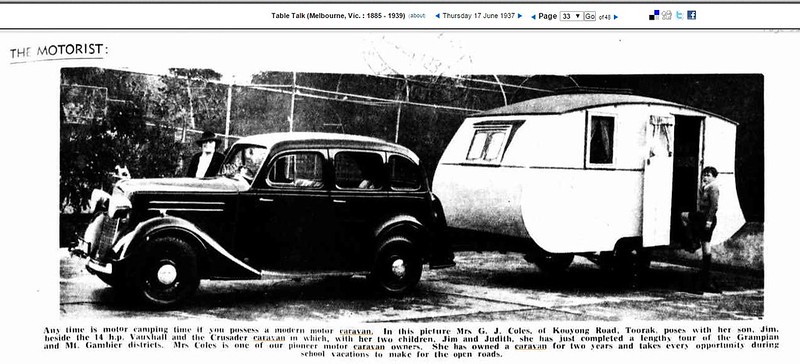 Crusader & Vauxhall - Table Talk (melb) 9-12-1937 by viva gt, on Flickr Crusader & Vauxhall - Table Talk (melb) 9-12-1937 by viva gt, on Flickr
My previous 'Trove' searches had not revealed a reference to Crusader Caravans so I did a new dedicated search for the name and found the following advertisement, which only appeared twice in The Argus, in early January 1937 and this one from 30 January, 1937. Searches from 1930 to 1940 found no other reference.
 Crusader - the Argus 30-1-1937e by viva gt, on Flickr Crusader - the Argus 30-1-1937e by viva gt, on Flickr
It seems Mr. Mackenzie not only liked an unusual style but rather oddly offered instruction in how to build vans as well.
On the original photo a small sign is visible behind the boys head and when enlarged it appears to read "Its a Crusader Caravan" which I really couldn't decipher when I first got the photo, maybe I didn't try hard enough.
The text in 'Table Talk' indicates Mrs. Coles 'has owned a van for two years' and it may not have been this one so with lack of further advertising it is not known how long Crusader caravans operated for, but it would appear not long at all.
Its at least nice to know that we had an Aussie Crusader long before those ones from across the ditch came on the scene!
George
|
|
|
|
Post by Don Ricardo on Aug 8, 2015 17:19:16 GMT 10
G'day Griffin, Thanks for posting the info about the Crusader van. What an interesting design with the concave rear. You'd think it would reduce the usable space in the van quite considerably, but maybe Mr Mackenzie adopted that shape as being more aerodynamic? Just to add a bit of trivia to your post, I'm almost 100% certain that the 'Mrs G J Coles' who owned the van was the wife of G J Coles who founded the Coles variety stores, which were eventually transformed into the Coles supermarket chain that now competes nationally with Woolworths. G J Coles, became Sir George Coles, and Mrs Coles became Lady Margaret. Great to see that Mrs Coles was an early adopter of the caravan, and a bit of an advocate for women caravanners, apparently. (Not to mention an ambassador for Vauxhall!    ) Don Ricardo |
|
|
|
Post by Don Ricardo on Mar 21, 2019 11:29:39 GMT 10
Morning all, Back in August 2015, Griffin posted some 1937 pics of a pre-War, Victorian built Crusader caravan owned by Mrs G J Coles (see posts above). The caravan and the photo were marvellous, and we identified 'Mrs G J Coles' as the wife of G J Coles who founded the Coles variety stores that eventually became the Coles grocery chain we know now. In the caption to one of the photos, reference is made to a recent trip Mrs Coles made to Mt Gambier and the Grampians. As it happens I just discovered an article printed in the Melbourne Herald on Tuesday, 17 May 1938 (page 22) reporting on Mrs Coles' love of caravanning and the trip referred to in the caption to the photo. It is quite an interesting article in that it tells us how caravanners in the 30's went about their trips. But in fact Mrs Coles approach doesn't sound a whole lot different to that of some modern vintage vanners! 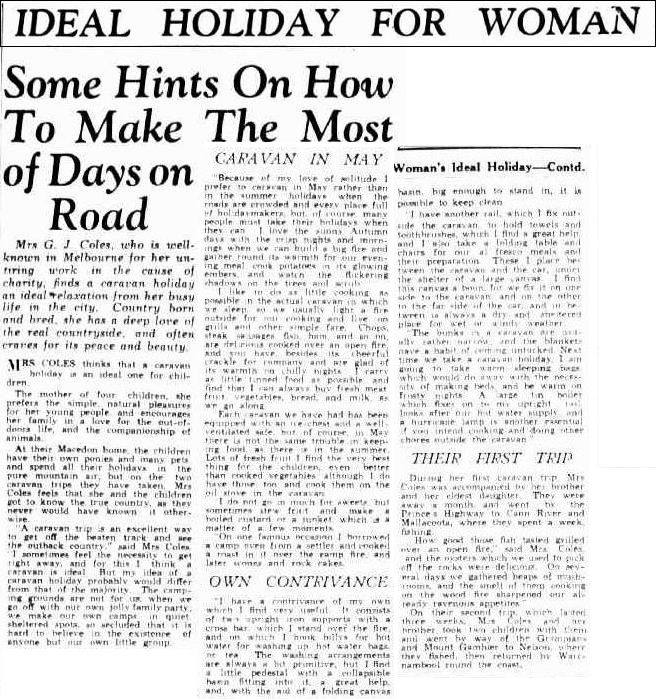 (Source: National Library of Australia nla.gov.au/nla.news-article243157853 ) The article was printed in a four page spread on caravans published by the Herald in conjunction with the 1938 Melbourne motor show, which had a special display of caravans. Note that I have reconfigured the columns in the article to save space and improve readability. However, even so it is not particularly easy to read, so here's a transcription (thank Trove!    ).
IDEAL HOLIDAY FOR WOMAN
Some Hints On How To Make The Most of Days on Road
Mrs G, J. Coles, who is well known in Melbourne for her untiring work in the cause of charity, finds a caravan holiday an ideal relaxation from her busy life in the city. Country born and bred, she has a deep love of the real countryside, and often craves for its peace and beauty.
MRS COLES thinks that a caravan holiday is an ideal one for children.
The mother of four children, she prefers the simple, natural pleasures for her young people, and encourages her family In a love for the out-of-doors life, and the companionship of animals.
At their Macedon home, the children have their own ponies and many pets, and spend alt their holidays in the pure mountain air, but on the two caravan trips they have taken, Mrs Coles feels that she and the children got to know the true country, as they never would have known it other wise.
"A caravan trip Is an excellent way to get off the beaten track and see the outback country," said Mrs Coles. "I sometimes feel the necessity to get right away, and for this I think a caravan is ideal. But my idea of a caravan holiday probably would differ from that of the majority. The camping grounds are not for us, when we go off with our own jolly family party; we make our own camps in quiet, sheltered spots, so secluded that it is hard to believe in the existence of anyone but our own little group.
CARAVAN IN MAY
"Because of my love of solitude I prefer to caravan in May rather than in the summer holidays when the roads are crowded and every place full of holidaymakers, but. of course, many people must take their holidays when they can. I love the sunny Autumn days with the crisp nights and mornings when we can build a big fire and gather round its warmth for our evening meal, cook potatoes in its glowing embers, and watch the flickering shadows on the trees and scrub.
"I like to do as little cooking as possible in the actual caravan in which we sleep, so we usually light a fire outside for our cooking and live on grills and other simple fare. Chops, steak, sausages, fish, ham. and so on, are delicious cooked over an open fire, and you have, besides, its cheerful crackle for company and are glad of its warmth on chilly nights. I carry as little tinned food as possible, and find that I can always buy fresh meat, fruit, vegetables, bread, and milk, as we go along.
"Each caravan we have had has been equipped with an ice-chest and a well-ventilated safe, but, of course, in May there is not the same trouble in keeping food, as there is in the summer. Lots of fresh fruit I find the very best thing for the children, even better than cooked vegetables, although I do have those, too, and cook them on the oil stove in the caravan.
"I do not go in much for sweets, but sometimes stew fruit and make a boiled custard or a junket, which is a matter of a few moments.
"On one famous occasion I borrowed a camp oven from a settler and cooked a roast in it over the camp fire, and later scones and rock cakes.
OWN CONTRIVANCE
"I have a contrivance of my own which I find very useful. It consists of two upright iron supports with a cross bar, which I stand over the fire, and on which I hook billys for hot water for washing up, hot water bags,
or tea. The washing arrangements are always a bit- primitive, but I find a little pedestal with a collapsible basin fitting into it. a great help, and, with the aid of a folding canvas basin, big enough to stand in, it is possible to keep clean.
"I have another rail, which I fix out side the caravan, to hold towels and toothbrushes, which I find a great help, and I also take a folding table and chairs for our al fresco meals and their preparation. These I place between the caravan and the car, under the shelter of a large canvas. I find this canvas a boon, for we fix it on one side to the caravan, and on the other to the far side of the car, and in between is always a dry and sheltered place for wet or windy weather.
"The bunks in a caravan are usually rather narrow, and the blankets have a habit of coming untucked. Next time we take a caravan holiday, I am going to take warm sleeping bags, which would do away with the necessity of making beds, and be warm on frosty nights. A large tin boiler which fixes on to my upright rail, looks after our hot water supply, and a hurricane lamp is another essential if you intend cooking and doing other chores outside the caravan."
THEIR FIRST TRIP
During her first caravan trip, Mrs Coles was accompanied by her brother and her eldest daughter. They were away a month, and went by the Prince's Highway to Cann River and Mallacoota, where they spent a week, fishing.
"How good those fish tasted grilled over an open fire," said Mrs Coles, "and the oysters which we used to pick off the rocks were delicious. On several days we gathered heaps of mushrooms, and the smell of them cooking on the wood fire sharpened our already ravenous appetites."
On their second trip, which lasted three weeks, Mrs Coles and her brother took two children with them and went by way of the Grampians and Mount Gambler to Nelson, where they fished, then returned by Warrnambool round the coast.
Don Ricardo |
|
sally
New Member

Posts: 2
|
Post by sally on Mar 26, 2019 10:51:32 GMT 10
Crusader Caravans
Mr. Mackenzie,
65 Crisp Street,
Hampton, Vic.
Nearly 10 years ago I obtained a copy of a photograph from the Vauxhall Owners' Club library showing a 1935 14hp DX Vauxhall towing a very unusual shaped van. The photo had no information recorded on it and I thought it was probably a home built van. This is the van:
 1935 DX with caravan-e by viva gt, on Flickr 1935 DX with caravan-e by viva gt, on Flickr
In my view a great looking little van with the concave rear, cambered roof and a rear entry door, it really ticks the boxes for me and if I were that way inclined I would happily build a replica.
Recently while catching up with additions of 'Table Talk' magazine on 'Trove' my Vauxhall search found none other than the photo of car and van, informing that it was a Crusader Caravan in the ownership of a Mrs. G.J. Coles. Herewith the photo from 'Table Talk'17 June, 1937.
 Crusader & Vauxhall - Table Talk (melb) 9-12-1937 by viva gt, on Flickr Crusader & Vauxhall - Table Talk (melb) 9-12-1937 by viva gt, on Flickr
My previous 'Trove' searches had not revealed a reference to Crusader Caravans so I did a new dedicated search for the name and found the following advertisement, which only appeared twice in The Argus, in early January 1937 and this one from 30 January, 1937. Searches from 1930 to 1940 found no other reference.
 Crusader - the Argus 30-1-1937e by viva gt, on Flickr Crusader - the Argus 30-1-1937e by viva gt, on Flickr
It seems Mr. Mackenzie not only liked an unusual style but rather oddly offered instruction in how to build vans as well.
On the original photo a small sign is visible behind the boys head and when enlarged it appears to read "Its a Crusader Caravan" which I really couldn't decipher when I first got the photo, maybe I didn't try hard enough.
The text in 'Table Talk' indicates Mrs. Coles 'has owned a van for two years' and it may not have been this one so with lack of further advertising it is not known how long Crusader caravans operated for, but it would appear not long at all.
Its at least nice to know that we had an Aussie Crusader long before those ones from across the ditch came on the scene!
George |
|
sally
New Member

Posts: 2
|
Post by sally on Mar 26, 2019 11:21:13 GMT 10
Hi Griffin and Don Duncan Mackenzie was my great grandfather - he was an architect/draftsman with the Victorian Public Works Department (PWD). He lived in Hampton and was an enthusiastic wooden (speed) boat builder (he was founder of Sandringham Yacht Club) - I gather he loved working with curved wood.I believe Duncan became fascinated by caravans and as you point out had some rather different design ideas - maybe borrowed from his sea-faring flare? Duncan's son ( my maternal grandfather) Aubrey ( affectionately known as "AD" ) started out in the PWD and worked on the Great Ocean Rd as a digger returning from WW1. It is likely this experience influenced or confirmed his interest in preserving and encouraging enjoyment of our environment and open spaces. AD became a civil engineer - and was longtime Chair of Melb Harbour Trust, on the foreshore erosion board, Country Roads board and significantly for this forum - Chair of Vic Tourism. Duncan owned Hampton Motors which was set up for his son, Eric, to work at - and, my mother told me - for his single daughter, Flora, to run the caravan hiring business !! ( I wonder if she was the first woman to run a caravan hiring business??) On 17 May 1938 AD wrote a full page illustrated article in the Herald (page 19) espousing the vitrues of caravaning - this was less than a month after Duncan's death and (although a blatant conflict of interest) I suspect it was a sort of anonymous tribute to his Dad. The article online on Trove is rather faded - I have an original copy in my grandfather's scrap book but its a bit large (>5MB) to upload - here's the link to the article trove.nla.gov.au/newspaper/article/243157825?browse=ndp%3Abrowse%2Ftitle%2FH%2Ftitle%2F1190%2F1938%2F05%2F17%2Fpage%2F26409694%2Farticle%2F243157825that edition of the Herald has a few articles on Caravans including one on the growing RACV Caravan club - trove.nla.gov.au/newspaper/article/243157819?browse=ndp%3Abrowse%2Ftitle%2FH%2Ftitle%2F1190%2F1938%2F05%2F17%2Fpage%2F26409695%2Farticle%2F243157819 |
|
|
|
Post by griffin on Mar 28, 2019 21:07:47 GMT 10
Hi Sally
Thanks for the additional information on Duncan Mackenzie, it's great to have some background and personal information on these pioneers in the industry.
George
|
|
|
|
Post by Don Ricardo on Apr 2, 2019 11:10:13 GMT 10
Hi Sally, It's so wonderful to read your post, and to hear about your great grandfather's interest in boats and caravans, and also about the involvement of his children in the caravan hiring business. It's always fabulous to hear from the families of the caravan builders from the vintage era, and of course the pre-War period like your family. I would be interested to know why Duncan built the van we've seen the photo of with a concave rear, whether it was for aerodynamic or practical reasons, or just because he could! Do you have any ideas how many caravans he built? I gather there was a few if he set up a caravan hiring business for Flora. As it happens, just a couple of days before you posted, I posted the illustration from your grandfather Aubrey's article on the forum in a section on caravan shows here. As you are aware the article was published in connection with the caravan display at the 1938 Melbourne International Motor Show, and of course was also accompanied by the article about Mrs G J Coles' caravanning exploits (posted higher up this thread). However, I did not make the family connection between the "Mr Mackenzie" who built Mrs Coles' caravan and "A D Mackenzie" who wrote the article! You've provided the link to the article, but it's quite hard to read on the Trove website, so I thought I'd post an image of it together with a transcription to make it more accessible to forum members. It provides a wonderful link to your great grandfather and his children: 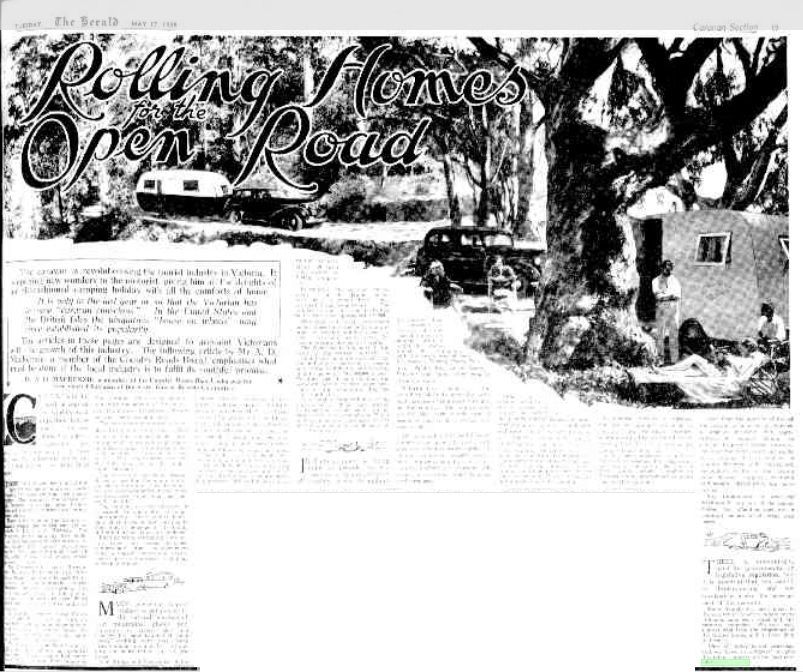 (Source: National Library of Australia nla.gov.au/nla.news-article243157825 Published in the Melbourne Herald, Tuesday, 17 May 1938, page 19)
Rolling Homes for the Open Road
The caravan is revolutionising the tourist industry in Victoria. It is opening new wonders to the motorist, giving him all the delights of an old-fashioned camping holiday with all the comforts of home.
It is only in the last year or so that the Victorian has become "caravan conscious". In the United States and the British Isles the ubiquitous "house on wheels " long since established its popularity.
The articles in these pages are designed to acquaint Victorians with the growth of this industry. The following article by Mr A. D. Mackenzie, a member of the Country Roads Board, emphasises what must be done if the local industry is to fulfil its youthful promise.
BY A. D. MACKENZIE, a member of the Country Roads Board, who was for for three years Chairman of the State Tourist Resorts Committee.
CATERING to travel is one of the world's most important industries. I do not claim to have originated that idea(?) or its expression. It was first said by a famous historian, and it was never truer than it is today.
THERE have never been anything like the volume of journeys frankly for pleasure that are made, today. The reason is the desire of all humans to escape fixed localities and everyday routines and enjoy new scenes. There is no state in the Commonwealth where the tourist can get so much for his £ as in Victoria. Six hundred miles long by 300 wide, this state has concentrated within its boundaries all the natural attractions spread individually through each of the other States, and many more peculiar to itself.
The Government Tourist Bureau,the Railways Betterment and Publicity(?) Board, the State Tourist Committee, and innumerable tourist leagues, progress associations and municipalities alive to the potentialities of the industry, are doing their part in a constructive and able manner. Not the least agency is the Country Roads Board, which, with its wonderful arterial road development and tourist road system, takes the tourist(?), by excellent roads, right into the heart of Nature.
Thirty years ago, a day's travel of ? miles was almost an eventful journey. Many people had never travelled so far from their homes in their lifetime. Then, in one generation, with the advent of the motor car, boundaries disappeared, distant horizons were brought near.
The only element required to complete this new mobility was a place to live in when touring, a place providing at all times and in all places amenities comparable with those one is accustomed to enjoy in his own home. This requirement has undoubtedly been met by the modern trailer caravan. The caravan brings those faraway places nearer for the whole family, and permits the tourist, by this colorful and most economical travel mode yet discovered to see what lies "beyond the hills."
The caravan can go wherever it is possible for the motor car to go. Consequently, these rolling homes have given travel a new meaning to thousands. The scope for the family of limited means is greatly widened. Pitching tents, struggling with unruly ropes and stakes, disturbed tempers and other inconveniences make no appeal to many who, nevertheless, possess the desire to holiday in remote regions.
MANY women have wished to get nearer to the natural beauties of our mountains, glades and waterfalls, or rivers, lakes and beaches, but have baulked at going "bush," cooking over open campfires, dodging ants and flies and digging the choice cutlet out of the ashes.
The fittings and furnishings of the modern caravan, however, inspire quite a different picture. Skilfully worked into their 14 ft. or there abouts, of length by 6 ft. of width, we find upholstered beds, abundant lockers, wardrobes, an ice chest, oil or petrol cooking and warming stoves, complete with oven, electric light, stainless steel sink and tables.
The modern caravan weighs between half a ton and one ton, tows easily at 30 to 40 m.p.h., with little increase in the fuel consumption of the car. In Victoria, there are probably between 1000 and 1500 of these rolling homes, about 50 per cent, owned by hiring companies.
In America, the caravan movement — or the Trailer movement, as it is known there — has assumed huge proportions. The number of vans in use in the United States this year approaches 600,000.
Municipal and local Government bodies there have vied with one another to provide suitable parks, in their towns and scenic areas, for accommodating this class of traffic.
The American is fully alive to the value of the tourist industry. It is stated that in Southern California, the industry is assessed as second only to the oil industry, and is estimated to be worth £40,000,000 a year. No other type of trade involving the spending public touches more sections of the community than the tourist industry.
It is roughly computed that, of the tourist's outlay, 20 per cent, goes in transportation, 20 per cent in food, 20 per cent in accommodation, 20 per cent in incidental purchases, 12 per cent in amusements and 8 per cent in refreshments.
IN Victoria, much is being done to provide for the caravanner by the provision of suitable areas throughout the country. This is apparent at many of our coastal resorts, among which might be mentioned Port Campbell, with its newly-erected comfort station, Barwon Heads, Torquay, Apollo Bay, Lome, Lakes Entrance and many other equally attractive spots.
Unfortunately, finance is the stumbling block to generally adequate provision being made through out the country. The requirements for the ideal park include ease of access by good roads or tracks, with easy grades.
The terrain should be well drained, timbered and generally level, with pure and adequate water supply. It should also possess sewered sanitation. Showers, laundry and community kitchens are desirable additions, also outdoor tables, benches, and fireplaces.
Important amenities are a central community hall, where social parties, dances, games and other entertainments may be conducted, and recreation areas, with provision for children's amusements, and a swimming pool and tennis courts.
All buildings should be rusticated(?) in design, and built, for example, in round timber and stone to harmonise with their surroundings. Regulations should be prescribed for the good government of such areas, relating particularly to cleanliness.
In Victoria, there is no registration fee on caravans, which is in contrast with American practice, where almost all States issue licences varying from 5/- to £3 a vehicle, the average being about £1.
It has been suggested as a basis for uniform practice that registration be paid at the rate of 25 cents, a 100lb. weight, which if applied to Victoria would approximate an average of £1 a caravan.
Apart from the question of having the caravan as a means of revenue, it appears desirable that registration of vehicles should be effected to permit skilled supervision over the types using our roads. It is essential that all vehicles be soundly designed, and constructed, particularly so far as the towing yoke, chassis, coupling, springing and weight distribution are concerned.
Any fundamental or structural weakness in any one of the details makes the offending road unit a potential menace, to all other road users.
THERE is, undoubtedly, need for governmental or legislative, regulation, but it is essential that this should be discriminating, and not calculated to hinder the development of the movement.
Much thought has been given to the subject in America, where many problems have been raised and apparently remedied, We can learn a great deal from the experience of the United States, and it is our duty to heed it.
After all, today is not yesterday, and we have an obligation to give this infant industry all the help possible.
Don Ricardo |
|
|
|
Post by Roehm3108 on Apr 2, 2019 16:28:21 GMT 10
Hi DonR. It's always great reading these historical documents, especially when a kind researcher goes to the trouble of providing a translation!!!  Regarding the question you asked Sally about that concave rear end of the van, it will be interesting to hear if she has any info on that feature. It has made me think a bit more about it however, and I wonder if it is actually a very clever design feature. It looks like that area has two storeyed bunk beds. Perhaps the bottom bunk also converts to a lounge during the day, in which case, if the upper bed is hinged to fold down and become the backrest for the lounge, the width of the bottom is such that the squab would still be nice and deep, even when the back is in position. At night, that bottom bunk could be almost wide enough for two children or one big adult. As for the upper berth, the design give a vertical walled box shaped space to that upper area, rather than the claustrophobic curve of a standard shaped van. This means the occupant of that bed would have much more movement space. WHen you think about it, that van would probably have to be close to a foot longer if built in the standard convex shape, to get the same amount of useable space in that rear area. In all, perhaps Mr Mackenzie was simply ahead of his time when it cam to design!  |
|
|
|
Post by Don Ricardo on Apr 3, 2019 9:09:02 GMT 10
G'day R3108,
I take your point about the rear layout of Mrs Coles' caravan. That makes sense. The design of the lower bunk/seat would also have provided extra storage room underneath the seat as well. In addition having the back curve echo the front curve may have just appealed to Mr Mackenzie's sense of form and aesthetics. It would be fascinating whether he used that design feature on all the caravans he built, or whether this was a one-off. I can't recall seeing any other caravan of that era in Australia, Great Britain or the USA with that styling. The closest you get are the duck tailed vans, which were not uncommon. So that might possibly make Duncan Mackenzie's design unique.
Thanks for the comment about the translation. Most of the work is done by Trove, and you just need to use a bit of human intelligence to correct any errors.
Don Ricardo
|
|
|
|
Post by Don Ricardo on Apr 5, 2020 20:56:17 GMT 10
G’day all, While doing some research a few minutes ago, the Search facility button helpfully turned up a connection between two items that we hadn’t made previously - namely that the Duncan Mackenzie who designed and built the unusual Crusader caravans shown on this thread, had previously built an aluminium clad caravan in 1934. As far as I am aware, it was the first Australian aluminium clad caravan. If not the first, then certainly amongst the first. It appears that Mr Mackenzie was an innovator. Don Ricardo Evening all, Here's a trivia question for you: When was the first aluminium caravan produced in Australia? Sometime in the 50's? Nup... Well, how about sometime in the late 40's? Nup... Give up? OK, try 1934. Photograph and article from The Argus, Wednesday, 26 September 1934, p. 4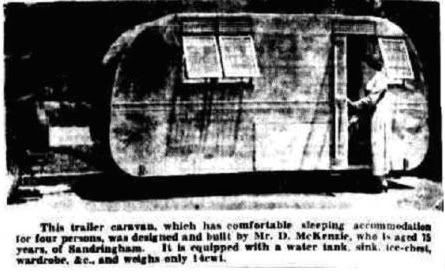 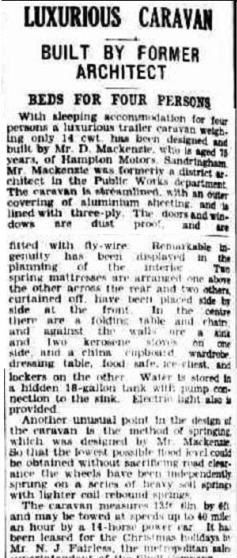 (Source: National Library of Australia nla.gov.au/nla.news-article11003425 )
Transcription of text:"LUXURIOUS CARAVAN "BUILT BY FORMER ARCHITECT "BEDS TOR FOUR PERSONS "With sleeping accommodation for four persons a luxurious trailer caravan weighing only 14 cwt has been designed and built by Mr D Mackenzie, who is aged 75 years, of Hampton Motors, Sandringham. Mr Mackenzie was formerly a district architect in the Public Works department. The caravan is streamlined with an outer covering of aluminium sheeting, and is lined with three-ply. The doors and windows are dust proof, and are fitted with fly-wire. Remarkable ingenuity has been displayed in the planning of the interior. Two spring mattresses are arranged one above the other across the rear and two others, curtained off, have been placed side by side at the front. In the centre there are a folding table and chairs and against the walls are a sink and two kerosene stoves on one side, and a china cupboard, wardrobe, dressing table, food safe, ice chest, and lockers on the other. Water is stored in a hidden 18-gallon tank with pump connection to the sink. Electric light also is provided. "Another unusual point in the design of the caravan is the method of springing which was designed bv Mr Mackenzie. So that the lowest possible floor(?) level could be obtained without sacrificing road clearance the wheels have been independently sprung on a series of heavy soil springs with lighter coil rebound springs. "The caravan measures 13ft 6in by 6ft and may be towed at speeds up to 40 miles an hour by a 14-horse power car. It has been leased for the Christmas holidays by Mr. N. J. Fairless, the metropolitan sales superintendent of the Shell Company."
ADDENDUM - AUGUST 2022:Following is a further article about Duncan Mackenzie's aluminium clad caravan showing something of the inside of the van, published in the Melbourne Herald on Thursday, 27 December 1934 (page 20): _Thurs_27Dec1934_p20_article243089265.png?width=1920&height=1080&fit=bounds) Note: Item reconstructed from Trove.)
It's interesting to see that the caravan had been hired for the Christmas holidays by Mr N J Fairless of the Shell Company and that the photo was provided by Shell. Wonder who arranged that and why? Did Shell see some advantage in encouraging motor caravanning? Quite possibly.
Don Ricardo
|
|
 1935 DX with caravan-e by viva gt, on Flickr
1935 DX with caravan-e by viva gt, on Flickr Crusader & Vauxhall - Table Talk (melb) 9-12-1937 by viva gt, on Flickr
Crusader & Vauxhall - Table Talk (melb) 9-12-1937 by viva gt, on Flickr Crusader - the Argus 30-1-1937e by viva gt, on Flickr
Crusader - the Argus 30-1-1937e by viva gt, on Flickr 1935 DX with caravan-e by viva gt, on Flickr
1935 DX with caravan-e by viva gt, on Flickr Crusader & Vauxhall - Table Talk (melb) 9-12-1937 by viva gt, on Flickr
Crusader & Vauxhall - Table Talk (melb) 9-12-1937 by viva gt, on Flickr Crusader - the Argus 30-1-1937e by viva gt, on Flickr
Crusader - the Argus 30-1-1937e by viva gt, on Flickr











_Thurs_27Dec1934_p20_article243089265.png?width=1920&height=1080&fit=bounds)